
Page 25: of Maritime Logistics Professional Magazine (Q4 2013)
Shipbuilding, Repair
Read this page in Pdf, Flash or Html5 edition of Q4 2013 Maritime Logistics Professional Magazine
www.maritimeprofessional.com | Maritime Professional | 25fee. There are also membership levels for academic institutions and afÞ liate orga- nizations such as equipment manufactur- ers, suppliers, trade associations, etc. The funds collected are utilized to develop in- dustry driven, modularized, craft speciÞ c standardized curriculum and assessments to meet the demands of the industry. Through NCCER, the NMEC has pro-grams that can be utilized to recruit and enhance the image of the shipbuilding and repair industry and generate national exposure. NCCER is a not-for-proÞ t 501 (c)(3) education foundation created by the construction industry to develop standardized curriculum with portable credentials and to help address the skilled construction workforce shortage. NCCER is recognized by the industry as the training, assessment, certiÞ cation, and career development standard for the construction and maintenance craft pro-fessional. And now, those standards are coming to the waterfront. Another equally attractive way for shipyards to reach the Promised Land is contract with a group such as Tradesmen International. Tradesmen is recognized for their ability to supply contingent la-bor, but it is their consultative services Ð particularly Labor Productivity Con- sulting Ð that has gotten notice by con-struction businesses. That tried-and-true formula, using a contractorÕs historical labor data, enables companies to deter- mine what their optimal permanent or core workforce total should be, and is also being applied to help the national shipyard industry. In essence, clients are ultimately able to run their businesses with a leaner permanent payroll and, through close interaction with Trades- men, are capable of supplementing their core employees with TradesmenÕs high-caliber craftsmen only as workload warrants it. The goal is two-pronged: substantially increase workforce pro- ductivity and project proÞ t margins. This bottom line gain gets put back into growing the business, providing en- hanced beneÞ ts for their employees and keeping up with technology. MP #4 18-33.indd 25MP #4 18-33.indd 2512/11/2013 1:05:42 PM12/11/2013 1:05:42 PM

 24
24

 26
26
